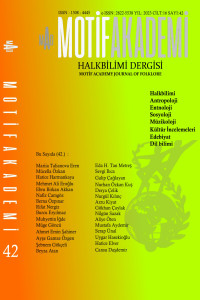KIRGIZ AĞITLARINDA BİR MİTOLOJİK UNSUR “AT”
A MYTHOLOGICAL ELEMENT IN KYRGYZ LAMENTS “HORSE”
Author(s): Rifat NergizSubject(s): Customs / Folklore, Studies of Literature, Oral history, Cultural Anthropology / Ethnology, Sociology of Literature
Published by: Motif Halk Oyunları Eğitim ve Öğretim Vakfı
Keywords: Myth; Turkish; Kyrgyz; horse; lament;
Summary/Abstract: Mythical narration facilitates the functioning of some social institutions in societies. In this context, there are various myths belonging to each nation and these reflect the human desires of the societies they belong to and are linked to the lifestyles and beliefs of the culture they exist in. From this point of view, myths are important in explaining primitive cultures as well as great civilizations and religions. Although some events in myths are said to have emerged randomly and ambiguously, there are also similarities between some historical events and myths. Although the stories told in the myths consist of the remnants of historical events and exaggerations, these historical events are also a source of inspiration for many branches of art. Literature is one of these branches of art. For example, it is widely believed that the Kyrgyz Manas Epic emerged from a lament. This epic with its origins in lament contains many mythological elements. The Kyrgyz are one of the oldest Turkish ethnonyms and have a rich oral culture. Since lament is thought to be the oldest oral literature product among oral genres, the explanation of some elements in Kyrgyz laments can only be through mythology. The word "ege" in Kyrgyz laments, meaning God and owner, can be given as an example. Another mythological element in Kyrgyz laments is the horse. In old Turkish beliefs, a horse is defined as an animal sacrificed to its Lord. This is because the idea that there is a connection between the horse and the sky is common. In addition, the idea that this animal descended from the sky and interacted with heaven is a common belief in prehistory. "The horse is the wing of man." even the proverb is enough to show the meaning that the Kyrgyz ascribe to the horse. Considering the burial and burial ceremonies in Kyrgyz history, it is possible to say that in this proverb, the horse is conceived not only as a mount, but also as an extraordinary creature that plays an important role in the transition to another realm, as in the example of "Pegasus". In this study, "horse" will be examined as a mythological element in the examples of laments included in the doctoral thesis named "Lament and Lamentation from Past to Present (Batken, Toktogul and Kara-Kulca regions lament samples)" and firstly, the relationship between lament and mythology will be mentioned, then Turks and Horse, Horse and Horse in World and Kyrgyz Literature. Finally, the names of horses in some Kyrgyz laments will be determined and information will be given about the mythological origins of these horses.
Journal: Motif Akademi Halkbilimi Dergisi
- Issue Year: 16/2023
- Issue No: 42
- Page Range: 608-618
- Page Count: 11
- Language: Turkish

